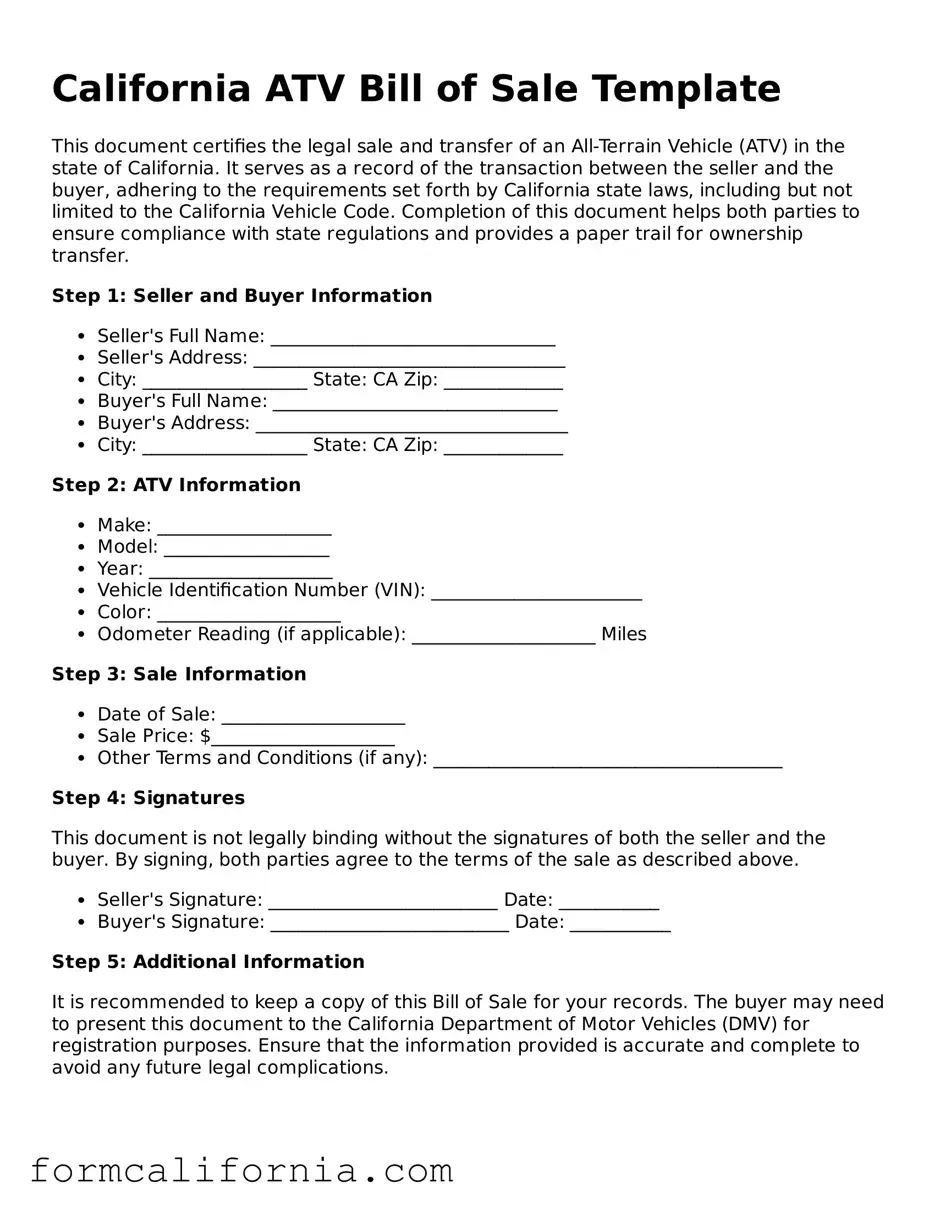The Boat Bill of Sale form is similar to the California ATV Bill of Sale form in that both are used to document the transfer of ownership of a vehicle from the seller to the buyer. This includes essential details such as the make, model, year, and identification number of the vehicle, along with the names and signatures of the parties involved and the sale price. The main difference lies in the type of vehicle each form pertains to: one is specifically for boats, while the other is for all-terrain vehicles (ATVs).
Similar to the California ATV Bill of Sale form, the Motor Vehicle Bill of Sale form is used to record the sale of a vehicle. It collects comparable information, such as the vehicle's description, the purchase price, and the parties' details. This form is necessary for the buyer to register and title their new vehicle with the Department of Motor Vehicles (DMV). It differs primarily in its broader application to various types of motor vehicles, including cars, trucks, and motorcycles, beyond just ATVs.
The Firearm Bill of Sale form also shares similarities with the California ATV Bill of Sale form, serving as a legal document that records the sale and transfer of a firearm from one individual to another. It includes specific details about the firearm, such as the make, model, caliber, and serial number, in addition to similar information about the buyer and seller. The critical difference lies in the item being transferred—this form is exclusive to firearms and often includes extra mentions regarding the buyer's eligibility to own a firearm.
Comparable to the California ATV Bill of Sale form, the General Bill of Sale form is a versatile document that can be used to document the sale of any type of personal property from one party to another. This could include items like electronics, furniture, or tools. It records crucial details about the transaction, including a description of the item, the sale amount, and the parties involved. The General Bill of Sale form is more flexible in terms of the items it covers, unlike the ATV-specific form.
The Equipment Bill of Sale form parallels the California ATV Bill of Sale form in purpose and function, documenting the sale of equipment between two parties. It details the equipment's description, including any make, model, and identification numbers, the transaction details, and the participants' information. This form is specifically designed for the transfer of ownership of machinery or large equipment, setting it apart from the more recreational focus of the ATV Bill of Sale.
Like the California ATV Bill of Sale form, the Business Bill of Sale form is utilized to record the sale of assets, in this case, those belonging to a business. This includes not only the tangible assets but also intangible ones like customer lists and goodwill. The form captures essential information about the sale, such as the description of the assets, the purchase price, and the parties' contact information. The Business Bill of Sale form is distinguished by its focus on business transactions, as opposed to the personal or recreational nature of the ATV sale.
The Aircraft Bill of Sale form, while serving a similar documentation purpose as the California ATV Bill of Sale form, is focused on the sale of airplanes and other types of aircraft. It includes detailed information about the aircraft being sold, such as the make, model, registration number, and serial number, alongside the standard details of the transaction and the parties involved. The specific application to aircraft sales differentiates it from the more general or ground-vehicle-oriented sales documented by the ATV Bill of Sale.
The Pet Bill of Sale form, though sharing the purpose of documenting a sale between two parties, is specific to the transfer of ownership of pets or animals. It records details about the pet, such as breed, color, and age, the sale price, and information about the buyer and seller. This form differs in its focus on living animals as opposed to inanimate vehicles or objects, highlighting the unique considerations involved in such transactions, like health guarantees or vaccination records.
